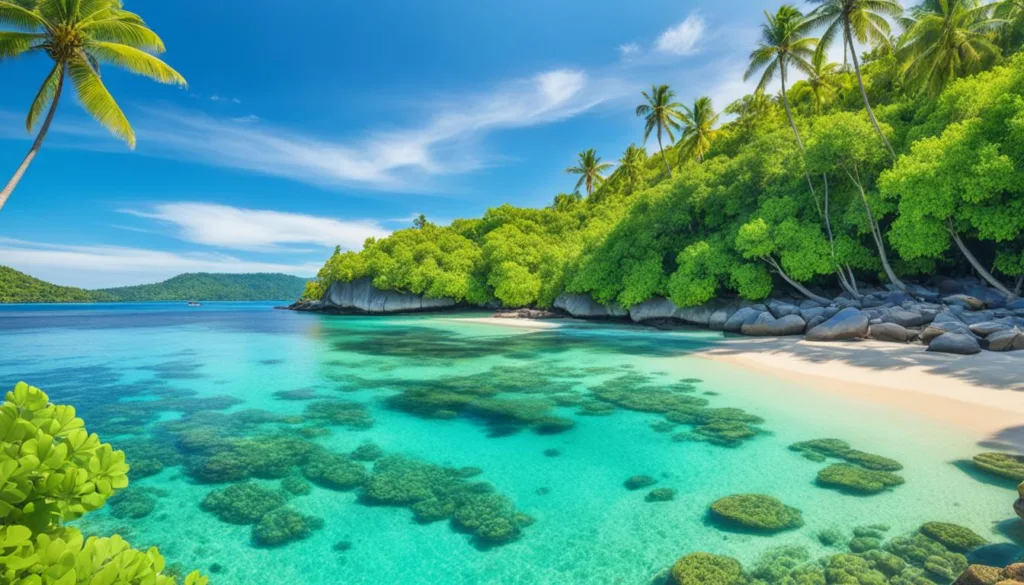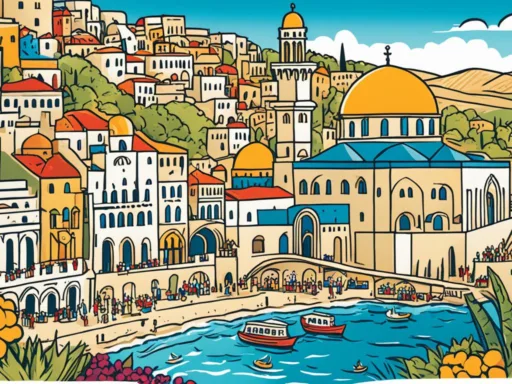Have you ever wondered what the perfect time to explore Indonesia is, factoring in both the splendor of island exploration and the joyous revelry of cultural festivals? Indonesia’s enchanting archipelago offers a myriad of experiences, but when is the Best Time to Visit Indonesia to fully embrace its natural beauty and vibrant traditions?
Indonesia’s whimsical weather patterns, with their recent unpredictability, still cradle the potential for that unforgettable getaway. Be it the sun-soaked beaches, the mesmerizing dance of cultural festivals, or the intrigue of majestic volcanoes, a meticulously timed visit can make all the difference. Dive into an in-depth look at the Indonesia travel seasons, tailored to help you capture the essence of this tropical paradise in its prime. Find out when the islands are ripe for discovery and festivities are in full swing in our guide, “Indonesia: Best Times for Island Exploration and Cultural Festivals.”
Key Takeaways
- Understanding Indonesia’s seasonal nuances is key to planning the perfect island getaway.
- Climate change has introduced more variability into Indonesia’s traditional weather patterns, affecting tourism.
- High season months like July and August, while crowded, still offer peak experiences for cultural and outdoor activities.
- Shoulder seasons provide a balance between favorable weather and fewer crowds, ideal for nature-centric adventures.
- January and February’s low season may surprise you with budget-friendly options and less crowded destinations.
- Festivals offer a colorful lens through which to experience Indonesia’s rich culture during different times of the year.
Understanding Indonesia’s Tropical Climate Diversity
Indonesia’s vast archipelago is a testament to the remarkable climate diversity that characterizes the region. This diversity, crucial to the country’s ecological and cultural richness, has long shaped the experiences of residents and travelers alike. However, the predictable seasonal patterns once used to plan farming, festivals, and travels are now being altered by the broad-reaching effects of climate change.
Impact of Climate Change on Seasonal Weather
The traditional division into wet and dry seasons in Indonesia no longer holds the reliability it once did. With climate change impacts in Indonesia, phenomena such as El Niño and La Niña have started to exert significant influence, leading to increased frequency and intensity of weather extremes. This has vital implications for the country, touching upon everything from agricultural scheduling to tourism planning and infrastructure development.
Varied Weather Patterns Across Indonesian Archipelago
Diverse regional climates form the Indonesian weather canvas, from the balmy beaches of Bali to the rain-drenched highlands of Papua. The stark variance in seasonal weather in Indonesia underscores the importance for travelers and locals to remain vigilant and prepared. Whether it’s surfing in Lombok’s dry season or enjoying the cultural tapestry of Java in the wetter months, understanding these patterns is key to making the most of Indonesia’s rich environmental tapestry.
- Bali and Lombok – Dry seasons with minimal rainfall, ideal for beach tourism and outdoor activities.
- West Papua and Maluku – Wet seasons in July and August, offering lush landscapes and cooler climates.
- Java – A mixed bag with wet seasons bringing life-giving rain for agriculture and vibrant green landscapes, but potentially disrupting travel plans.
Unveiling the Ideal Period for Beach Enthusiasts and Party-Goers
For those with a penchant for sun-kissed shores and vibrant nightlife, the best season to travel Indonesia aligns with the high season months. Particularly, the islands of Bali and Lombok become the epicenters of excitement with their renowned beach parties Indonesia is famous for, and offer numerous outdoor activities suited for every kind of traveler.
Bali and Lombok during High Season
These island paradises promise an unparalleled beach experience when the sun reigns supreme in the sky. It’s during this peak time for Indonesia vacations that the islands pulsate with energy, drawing in those seeking the quintessential tropical getaway.

However, the influx of tourists to Bali and Lombok means popular sites are often bustling with activity, necessitating careful planning. Here are key considerations for those looking to indulge in the heightened merriment of the high season:
| Consideration | High Season | Festive Year-End |
|---|---|---|
| Weather | Optimal Sun Time | Moderate Rainfall |
| Crowds | Highest | High |
| Accommodation Costs | Peak Prices | Increased Rates |
| Activity Options | Diverse | Seasonal Specials |
Navigating the Highs of Peak Season Tourism
The allure of this period is undeniable, yet it’s crucial for beach-goers and party enthusiasts to book accommodations and flights well in advance to manage costs. Embracing the exhilaration of high season requires a blend of planning and spontaneity to fully delve into the heart of Indonesia’s ceaseless revelry.
Embarking on Natural Adventures in the Shoulder Season
Nestled between the extremes of peak and off-peak travel times, the shoulder season in Indonesia opens the door to unique and astounding natural excursions. Renowned as the best time to explore Indonesia, the periods from March to June and September to November balance the bustling vibrancy of high tourist seasons with the serenity of less frequented months. For travelers yearning for both adventure and tranquility, these months are a matchless time for Indonesia natural adventures.
During the shoulder season, one can venture into the depths of Indonesia’s forests or plunge into its sapphire-blue seas with far fewer interruptions. It’s a period that’s synonymous with shoulder season Indonesia—a phrase that’s as much about the experience as it is about timing.
Witness Wildlife: Orangutans and Mola Mola Spotting
There is perhaps no greater highlight for wildlife enthusiasts than the chance to see some of Indonesia’s most iconic species thriving in their natural habitat. Observing orangutans swing through the canopies of Sumatra and Kalimantan, or being graced by the presence of the mystical mola mola sunfish while diving, are experiences best had when crowds thin out.
Trekking and Diving: Optimal Conditions Away from Peak Crowds
Trekking across Indonesia’s volcanic landscapes becomes a more intimate affair during the shoulder months. Wanderlust-driven souls can take to the hills without the hubbub of peak season, finding better conditions for both leisurely strolls and challenging ascents. Likewise, the underwater world becomes a private playground, where diving alongside whale sharks and vibrant coral reefs feels like an encounter reserved just for you.
- Optimal trekking conditions on Indonesia’s majestic volcanoes
- Increased opportunities for wildlife encounters
- Perfect climate for diving adventures without the congestion of peak travel periods
However, visitors should note the occasional smoke haze resulting from agricultural practices during certain times, particularly from September to November. This serves as an important consideration for those with susceptibility to respiratory conditions. Nevertheless, for the clear majority of nature adventurers, the shoulder season remains a period teeming with life and devoid of the usual excesses of tourism—a time when Indonesia truly reveals its natural splendor.
Best Time to Visit Indonesia: Low Season Surprises
For savvy travelers aiming for an optimal period for an Indonesia trip, the low season months of January and February offer compelling reasons for selecting this window for their exploration. Often overlooked in favor of Indonesia’s peak seasons, traveling during these traditionally wetter months bears unexpected fruits, particularly for those in pursuit of low season travel Indonesia experiences.

While the threat of rain might deter some visitors, this period bestows unique opportunities for cultural insights and a more intimate connection with Indonesia’s lush landscapes. Surprisingly sunny intervals punctuate the mostly short-lived downpours, leaving ample time to uncover Indonesia’s rich heritage at significantly quieter historical sites.
West Papua and Maluku, in particular, enter their coveted dry spell during this time. Visitors can indulge in an Indonesia off-season exploration of these regions, shedding the crowds for a more serene engagement with nature. From trekking through unspoiled rainforests to languorous days amidst pristine beaches, the low season travel climate is ripe for discovery and relaxation.
If advantages had to be distilled into a bullet list, the allure of Indonesia during its low season would include:
- Cost-effective travel and accommodation options
- Solitary temple visits, ideal for those seeking peaceful cultural experiences
- Access to outdoor adventures in West Papua and Maluku under idyllic conditions
- Transitioning into honing a truly authentic perspective of Indonesian daily life
Indeed, low season offers a treasure trove of advantages for the thoughtful traveler, providing a striking balance between budget-friendly options and blissful seclusion in one of the most diverse countries on the planet.
Special Months for Cultural Festivals and Events
If you’re planning when to go to Indonesia for a culturally rich experience, timing your visit with the country’s vibrant festivals can add an unforgettable dimension to your journey. Indonesia cultural festivals offer a deeply immersive window into the heritage and traditions of this diverse archipelago. Let’s explore the top months to immerse yourself in these unique festivities.

Experiencing Bali’s Spiritual Nyepi Day
The Balinese “Nyepi Day,” or the Day of Silence, marks a poignant pause across the island, typically observed in March. It’s a time for introspection and spiritual renewal, a concept rarely found in today’s bustling world. Streets fall silent, lights are dimmed, and the entire island takes a break from the usual day-to-day activities, offering a serene and contemplative atmosphere that is both rare and enriching.
Navigating Indonesia’s Festive Calendar: Ramadan to Independence Day
Indonesia’s festive calendar is brimming with events throughout the year, but certain months are particularly eventful. January begins with the colorful Chinese New Year celebrations, whereas February features the unique Pasola festival in Sumba. When April arrives, so does Kartini Day, dedicated to Indonesia’s women and their empowerment.
The dry season spanning May to September coincides with numerous religious and national festivals, including the Buddha’s Waisak Day and the exuberant Independence Day celebrations in August. The holy month of Ramadan also falls between March and April, paving the way for a quieter ambiance across Indonesia, with less crowded tourist spots and a chance to witness the nation’s devotional practices.
Whether you’re a cultural enthusiast or a traveler seeking to enrich your trip with local customs and celebrations, Indonesia presents a year-round tapestry of festivals that reflect the country’s rich mosaic of traditions. Planning your visit around these special times not only promises an engaging experience but also deeper insight into the soul of this fascinating country.
Bali and Beyond: Region-Specific Travel Recommendations
When planning your Indonesian adventure, understanding the distinct Bali travel seasons, as well as other regional timings, will enrich your experience. Each unique region within Indonesia has an ideal time to visit, offering a climate and cultural panorama tailor-made for specific interests and activities.

The table below presents a snapshot of travel recommendations in Indonesia, focusing on the optimal times to visit Bali, Jakarta, Lombok, West Papua, and the Maluku Islands. Here, you’ll find a concise guide to each region’s prime season, ensuring your trip aligns with the best local climate and festivities.
| Region | Optimal Travel Season | Highlights | Note on Festivities |
|---|---|---|---|
| Bali | May to September | Warm temperatures, low rainfall, excellent for beaches and cultural exploration | Peak tourist season, especially in July and August |
| Lombok | November to March | Best surfing conditions | Relatively quieter than Bali; festivities are more local |
| Jakarta | June to September | Clear weather perfect for historical tours | Coincides with national events and public holidays |
| West Papua | April to November | Ideal for adventure travel and exploration | Observe local customs unaffected by peak seasonal tourist influx |
| Maluku Islands | May to October | Prone to long dry periods, great for beach and marine activities | Experience authentic regional festivities |
Take note that regional travel in Indonesia might coincide with significant cultural events such as Ramadan, which can dramatically alter the typical travel experience. A careful consideration of both the regional travel seasons in Indonesia and local holidays is essential for a fully-rounded itinerary.
Whether your journey takes you to the vibrant shores of Bali or the underrated beauty of the Maluku Islands, aligning your travel schedule with regional climates and festivities ensures an unforgettable Indonesian exploration.
Conclusion
Finding the quintessence of your Indonesian journey involves syncing with the rhythm of the islands – a complex melody composed of climate nuances and regional festivities. As we’ve traversed through various seasons and cultural highlights, one thing remains clear: the best time to immerse yourself in Indonesia is deeply personal, contingent upon what you want to encounter and experience.
Summing Up the Ultimate Times for your Indonesian Getaway
Island exploration Indonesia beckons with a kaleidoscope of experiences. The high-octane revelry of beach parties and electrifying cultural festivals Indonesia bursts into full swing during peak seasons. Yet, for those seeking communion with nature or a journey less clustered, shoulder seasons offer a sanctuary where adventure and serenity strike a harmonious balance. Not to be underrated, the low season entices with its tranquil embrace and softer whispers of culture, sweetened with economic benevolence.
Personalizing Your Travel Plans Based on Climate and Festivities
Embarking on the task of personalizing Indonesia trip brings forth the joy of tailor-making a tapestry of memories. Whether you long for the pulsating dance of Bali’s sands beneath the summer sky, the spiritual silence during Nyepi, or the lush, verdant secrets unveiled by the rains of Java, your itinerary can be as unique as the archipelago’s myriad of islands. By aligning your travel plans with the mosaic of Indonesia’s climate intricacies and vibrant celebrations, you capture more than photos – you capture the essence of an enchanting world waiting to be explored.






